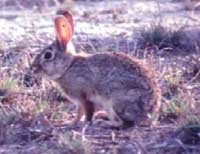Desert Cottontail (Sylvilagus audubonii)

TPWD ©
- Description
- This rabbit is a medium-sized cottontail. It is a buff-brown color lined with black above and white below. They have relatively long ears and, like most rabbits, they are quick on their feet.
- Life History
You can tell when a cottontail has been around by their droppings. Cottontails deposit two kinds of fecal pellets. The hard and brown pellets are formed from fully digested plant materials, while the soft and green pellets are only partially digested materials. Rabbits must reingest these soft pellets to extract the full nutritional value from their food. This process is called caprophagy. Cottontails feed on grasses and green plants, during the spring and summer and on bark and twigs during the fall and winter months.
Desert Cottontails take refuge in other animal's burrows as well as in their own scratched-out depressions. These pear-shaped burrows are lined with dried grasses and filled with rabbit fur in anticipation of baby cottontails. Desert Cottontails may raise two or more litters a year with one to six young in each litter. The young are born hairless and blind after a gestation period of about a month. Cottontails may live up to two years in the wild.
- Habitat
- Desert Cottontails are adapted to various habitats from grasslands to cactus deserts. They prefer brushy areas that include pre-established burrowing systems.
- Distribution
- Desert Cottontails are prevalent from California to the western half of Texas, north to eastern Montana and southwestern North Dakota.
- Other
- These cottontails frequently are associated with prairie dog towns. Cottontails are preyed upon by animals such as hawks, foxes, owls and snakes.